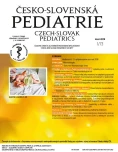Evaluating electrical cortical activity using amplitude-integrated electroencephalography in term neonates during phototheraphy
Authors:
Z. Zimová; K. Maťašová; M. Zibolen
Authors‘ workplace:
Neonatologická klinika, Jesseniova lekárska fakulta v Martine, Univerzita Komenského v Bratislave, Univerzitná nemocnica Martin
Published in:
Čes-slov Pediat 2018; 73 (1): 16-22.
Category:
Overview
Amplitude-integrated encephalography (aEEG) is a non-invasive method of continuous monitoring of neonatal brain activity. Thanks to being fairly easy to evaluate, requiring little preparation time, and its small size, aEEG is currently a common part of standard neonatal care in NICUs. The incidence of significant hyperbilirubinaemia in term newborns is approximately 10%. Phototherapy has remained the first choice therapeutic intervention for more than 50 years, and it is undergone by a large portion of children. Several adverse effects of phototherapy have been described.
In our study, we analyzed the effect of hyperbilirubinaemia and phototherapy on the electrical cortical activity of the neonatal brain with the use of aEEG. After comparing the control group (n=20) and the group of patients with hyperbilirubinaemia (n=20), no significant changes in any of the monitored aEEG indicators was detected. Equally, phototherapy as a treatment for hyperbilirubinaemia in the examined patient group did not cause significant differences in these parameters. The results indicate that hyperbilirubinaemia and phototherapy have no influence on the electrical cortical activity of the neonatal brain.
Key words:
amplitude-integrated electroencephalography, newborn, hyperbilirubinaemia, phototherapy
Sources
1. Hellstrom-Westas L, DeVries LS, Greisen G. Amplitude-integrated EEG classification and interpretation in preterm and term infants. Neoreviews 2006; 7 (2): 76–87.
2. Yurdakök M. Phototherapy in the newborn: what’s new? JPNIM 2015; 4 (2): 1–26.
3. El-Dib M, Massaro AN, Glass P, et al. Early amplitude integrated EEG and outcome of very low birth weight infants. Pediatr Int 2011; 53 (3): 315–321.
4. El-Dib M, Chang T, Tsuchida TN, et al. Amplitude - integrated electroencephalography in neonates. Pediatr Neurol 2009; 41 (5): 315–326.
5. Reenie JM, Chorley G, Boylan G, et al. Non-expert use of the cerebral function monitor for neonatal seizure detection. Arch Dis Child Fetal Neonatal 2004; 89 (1): 37–40.
6. Toet MC, Lemmers PMA. Brain monitoring in neonates. Early Hum Dev 2009; 85 (2): 77–84.
7. Kidokoro H, Kubota T, Hayashi N, et al. Absent cyclicity on aEEG within the first 24 h is associated with brain damage in preterm infants. Neuropediatrics 2010; 41 (6): 241–245.
8. Osredkar D, Toet MC, van Rooij LG, et al. Sleep-wake cycling on amplitude-integrated electroencephalography in term newborns with hypoxic - ischemic encephalopathy. Pediatrics 2005; 115 (2): 327–332.
9. Van Rooij LG, Toet M, Osredkar D, et al. Recovery of amplitude integrated electroencephalographic background patterns within 24 h of perinatal asphyxia. Arch Dis Child Fetal Neonatal Ed 2005; 90 (3): 245–251.
10. Casnocha-Lucanova L, Matasova K, Zibolen M, et al. Accuracy of transcutaneous bilirubin measurement in newborns after phototherapy. J Perinatol 2016; 36 (10): 858–861.
11. Parashari UC, Singh R, Yadav R, et al. Changes in the globus pallidus in chronic kernicterus. J Pediatr Neurosci 2009; 4 (2): 117–119.
12. Gürses D, Kiliç I, Sahiner T, et al. Effects of hyperbilirubinemia on cerebrocortical electrical activity in newborns. Pediatr Res 2002; 52 (1): 125–130.
13. Matasova K, Zibolen M, Čiljak M, et al. Spoľahlivosť neinvazívnaho merania koncentrácie bilirubínu u zdravých novorodencov. Čes-slov Pediat 2005; 60 (11): 599–605.
14. Matasova K. Neonatológia 1. Bratislava: Univerzita Komenského, 2012 : 1–155.
15. Raimondi F, Crivaro V, Capasso L, et al. Unconjugated bilirubin modulates the intestinal epithelial barrier function in a human-derived in vitro model. Pediatr Res 2006; 60 (1): 30–33.
16. Szucs KA, Rosenman MB. Family-centered, evidence-based phototherapy delivery. Pediatr 2013; 131 (6): 1982–1985.
17. Morris BH, Oh W, Tyson JE, et al. Aggressive vs. conservative phototherapy for infants with extremely low birth weight. N Engl J Med 2008; 359 (18): 1885–1896.
18. Demova K. Liecba novorodencov s patologickou nekonjugovanou hyperbilirubinemiou. http://slovenskaneonatologia.sk/wp-content/uploads/2017/04/Ovori%C5%A5-lie%C4%8Dbu-novorodencov-s-nekonjugovanou-hyperbilirubin%C3%A9miiou.pdf.
19. Burdjalov VF, Baumgart S, Spitzer AR. Cerebral function monitoring: a new scoring system for the evaluation of brain maturation in neonates. Pediatrics 2003; 112 : 855–861.
20. Hellstrom-Westas L, DeVries LS, Rosen I. Atlas of amplitude-integrated EEGs in the newborn. 2nd ed. London, UK: Informa Health Care, 2008 : 1–187.
21. Foreman SW, Thorngate L, Burr LR, et al. Electrode challenges in amplitude-integrated EEG: research application of a novel noninvasive measure of brain function in preterm infants. Biol Res Nurs 2011; 13 (3): 251–259.
22. Wennberg RP, Hance J. Experimental bilirubin encephalopathy: importance of total bilirubin, protein binding, and blood-brain barrier. Pediatr Res 1986; 20 (8): 789–792.
23. Tedford CE, DeLapp S, Jacques S, et al. Quantitative analysis of transcranial and intraparenchymal light penetration in human cadaver brain tissue. Lasers Surg Med 2015; 47 (4): 312–322.
24. Vigh B, Manzano MJ, Zádori A, et al. Nonvisual photoreceptors of the deep brain, pineal organs and retina. Histol Histopathol 2002; 17 (2): 555–590.
25. Fernandes AM, Fero K, Driever W, et al. Enlightening the brain: linking deep brain photoreception with behavior and physiology. Bioessays 2013; 35 (9): 775–779.
26. Chen A, Du L, Xu Y, et al. The effect of blue light exposure on the expression of circadian genes: bmal1 and cryptochrome 1 in peripheral blood mononuclear cells of jaundiced neonates. Pediatr Res 2005; 58 (6): 1180–1184.
27. Singh M, Jadhav HR. Melatonin: functions and ligands. Drug Discov Today 2014; 19 (9): 1410–1418.
28. Uhrikova Z, Zibolen M, Javorka K, et al. Hyperbilirubinemia and phototherapy in newborns: Effects on cardiac autonomic control. Early Hum Dev 2015; 91 (6): 351–356
Labels
Neonatology Paediatrics General practitioner for children and adolescentsArticle was published in
Czech-Slovak Pediatrics

2018 Issue 1
- What Effect Can Be Expected from Limosilactobacillus reuteri in Mucositis and Peri-Implantitis?
- The Importance of Limosilactobacillus reuteri in Administration to Diabetics with Gingivitis
Most read in this issue
- What disease can be hidden behind a diagnosis of erythema nodosum
- Neonatal pneumothorax – incidence and risk factors
- Neonatal outcomes of extremely preterm newborns in Czech Neonatal Network
- Measles in childhood – experience from the outbreak in Ostrava region in 2017
